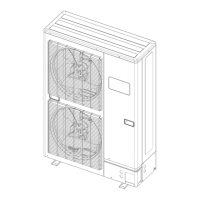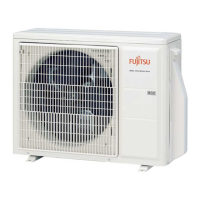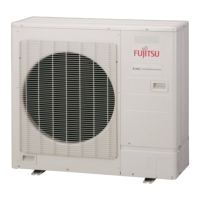5. PIPE INSTALLATION-1
5.1. Opening a knock out hole
CAUTION
Be careful not to deform or scratch the panel while opening the knock out holes.
To protect the piping insulation after opening a knock out hole, remove any burrs from
the edge of the hole. It is recommended to apply rust prevention paint to the edge of the
hole.
Pipes can be connected from 4 directions, front, lateral side, rear side and bottom. •
(Fig. A)
When connecting at the bottom, remove the service panel and piping cover on the •
front of the outdoor unit, and open the knock out hole provided at the bottom corner of
the piping outlet.
It can be installed as shown on “Fig. B” cutting out the 2 slits as indicated on “Fig. C”. •
(When cutting slits, use a steel saw.)
Fig. A
Service panel
Front
connection
Bottom
connection
(No. 1)
Lateral
connection
Rear
connection
Fig. B Fig. C
Slit
Slit
Bottom
connection
(No. 2)
5.2. Brazing
CAUTION
If air or another type of refrigerant enters the refrigeration cycle, the internal pressure in
the refrigeration cycle will become abnormally high and prevent the unit from exerting its
full performance.
Apply nitrogen gas while brazing the pipes. If a pipe is brazed without applying nitrogen
gas, an oxidation lm will be created.
This can degrade performance or damage the
parts in the unit (such as the compressor or
valves).
Pressure regulating valve
Cap
Brazing area
Nitrogen gas
Nitrogen gas pressure: 0.02 MPa
(= pressure felt sufciently on
the back of the hand)
CAUTION
For brazing material, use phosphor copper that does not require ux. Do not use ux to
braze pipes. If the ux is the chlorine type, it will cause the pipes to corrode.
Furthermore, if the ux contains uoride, it will adversely affect the refrigerant pipe
system such as by degrading the refrigerant.
If uoride is contained, quality of refrigerant deteriorates and affects the refrigerant
piping system.
5.3. Indoor unit pipe connections
5.3.1. Precautions for connecting simultaneous operation multi
CAUTION
Use genuine branch pipes for the refrigerant piping branches. Branch pipes are twin or
triple type for concurrent operation, and may be used for piping between the outdoor
and indoor units.
Select a twin or triple type branch pipe and purchase it before starting the installation
work.
Shorten the length of branch pipes from a branch to indoor unit as short as possible.
Maximum length: within 20 m.
Branch pipes shall be connected by welding (brazing).
Any vertical piping shall be in the part of the main piping. If a main pipe is bent, keep the
straight part more than 10 times the diameter of the connected pipe. A variance in the
amount of refrigerant may be caused if the straight part is short.
For details, refer to the Installation Manual of branch pipes.
5.3.2. Type of branch pipes
In case of a simultaneous operation multi (twin connection)
The liquid pipes and gas pipes shall be selected from the table below according to the
diameter, and welded.
Small pipe diameter
Liquid pipe Gas pipe
Large pipe diameter
Liquid pipe
Gas pipe
In case of a simultaneous operation multi (triple connection)
Weld the branch pipe shown at the left for liquid pipes, and the branch pipe shown at the
right for gas pipes.
5.4. Flare connection (pipe connection)
CAUTION
Do not use mineral oil on a ared part. Prevent mineral oil from getting into the system
as this would reduce the lifetime of the units.
While welding the pipes, be sure to blow dry nitrogen gas through them.
The maximum lengths of this product are shown in the table. If the units are further apart
than this, correct operation cannot be guaranteed.
5.4.1. Flaring
Use special pipe cutter and are tool exclusive for R410A.
(1) Cut the connection pipe to the necessary length with a pipe cutter.
(2) Hold the pipe downward so that the cuttings will not enter the pipe and remove any
burrs.
(3) Insert the are nut (always use the are nut attached to the indoor and outdoor
units respectively) onto the pipe and perform the are processing with a are tool.
Leakage of refrigerant may result if other are nuts are used.
(4) Protect the pipes by pinching them or with tape to prevent dust, dirt, or water from
entering the pipes.
Check if [L] is ared uniformly
and is not cracked or scratched.

